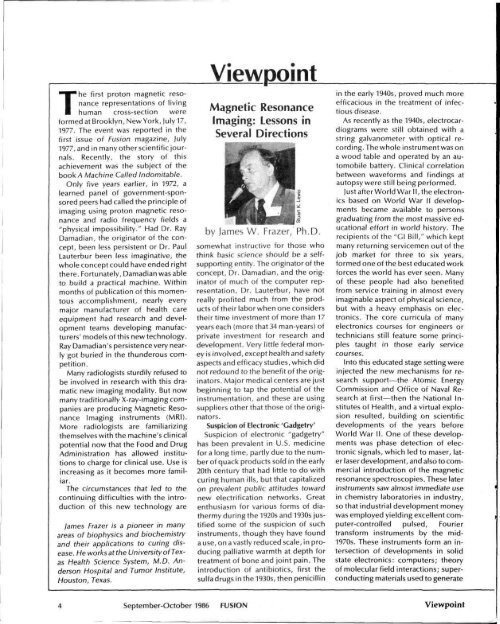You also want an ePaper? Increase the reach of your titles
YUMPU automatically turns print PDFs into web optimized ePapers that Google loves.
<strong>The</strong> first proton magnetic resonance<br />
representations <strong>of</strong> living<br />
human cross-section were<br />
formed at Brooklyn, New York, July 17,<br />
1977. <strong>The</strong> event was reported in the<br />
first issue <strong>of</strong> Fusion magazine, July<br />
1977, and in many other scientific journals.<br />
Recently, the story <strong>of</strong> this<br />
achievement was the subject <strong>of</strong> the<br />
book A Machine Called Indomitable.<br />
Only five years earlier, in 1972, a<br />
learned panel <strong>of</strong> government-sponsored<br />
peers had called the principle <strong>of</strong><br />
imaging using proton magnetic resonance<br />
and radio frequency fields a<br />
"physical impossibility." Had Dr. Ray<br />
Damadian, the originator <strong>of</strong> the concept,<br />
been less persistent or Dr. Paul<br />
Lauterbur been less imaginative, the<br />
whole concept could have ended right<br />
there. Fortunately, Damadian was able<br />
to build a practical machine. Within<br />
months <strong>of</strong> publication <strong>of</strong> this momentous<br />
accomplishment, nearly every<br />
major manufacturer <strong>of</strong> health care<br />
equipment had research and development<br />
teams developing manufacturers'<br />
models <strong>of</strong> this new technology.<br />
Ray Damadian's persistence very nearly<br />
got buried in the thunderous competition.<br />
Many radiologists sturdily refused to<br />
be involved in research with this dramatic<br />
new imaging modality. But now<br />
many traditionally X-ray-imaging companies<br />
are producing Magnetic Resonance<br />
Imaging instruments (MRI).<br />
More radiologists are familiarizing<br />
themselves with the machine's clinical<br />
potential now that the Food and Drug<br />
Administration has allowed institutions<br />
to charge for clinical use. Use is<br />
increasing as it becomes more familiar.<br />
<strong>The</strong> circumstances that led to the<br />
continuing difficulties with the introduction<br />
<strong>of</strong> this new technology are<br />
James Frazer is a pioneer in many<br />
areas <strong>of</strong> biophysics and biochemistry<br />
and their applications to curing disease.<br />
He works at the University <strong>of</strong> Texas<br />
Health Science System, M.D. Anderson<br />
Hospital and Tumor Institute,<br />
Houston, Texas.<br />
Viewpoint<br />
Magnetic Resonance<br />
Imaging: Lessons in<br />
Several Directions<br />
by James W. Frazer, Ph.D.<br />
somewhat instructive for those who<br />
think basic science should be a selfsupporting<br />
entity. <strong>The</strong> originator <strong>of</strong> the<br />
concept, Dr. Damadian, and the originator<br />
<strong>of</strong> much <strong>of</strong> the computer representation,<br />
Dr. Lauterbur, have not<br />
really pr<strong>of</strong>ited much from the products<br />
<strong>of</strong> their labor when one considers<br />
their time investment <strong>of</strong> more than 17<br />
years each (more that 34 man-years) <strong>of</strong><br />
private investment for research and<br />
development. Very little federal money<br />
is involved, except health and safety<br />
aspects and efficacy studies, which did<br />
not redound to the benefit <strong>of</strong> the originators.<br />
Major medical centers are just<br />
beginning to tap the potential <strong>of</strong> the<br />
instrumentation, and these are using<br />
suppliers other that those <strong>of</strong> the originators.<br />
Suspicion <strong>of</strong> Electronic 'Gadgetry'<br />
Suspicion <strong>of</strong> electronic "gadgetry"<br />
has been prevalent in U.S. medicine<br />
for a long time, partly due to the number<br />
<strong>of</strong> quack products sold in the early<br />
20th century that had little to do with<br />
curing human ills, but that capitalized<br />
on prevalent public attitudes toward<br />
new electrification networks. Great<br />
enthusiasm for various forms <strong>of</strong> diathermy<br />
during the 1920s and 1930s justified<br />
some <strong>of</strong> the suspicion <strong>of</strong> such<br />
instruments, though they have found<br />
a use, on a vastly reduced scale, in producing<br />
palliative warmth at depth for<br />
treatment <strong>of</strong> bone and joint pain. <strong>The</strong><br />
introduction <strong>of</strong> antibiotics, first the<br />
sulfa drugs in the 1930s, then penicillin<br />
in the early 1940s, proved much more<br />
efficacious in the treatment <strong>of</strong> infectious<br />
disease.<br />
As recently as the 1940s, electrocardiograms<br />
were still obtained with a<br />
string galvanometer with optical recording.<br />
<strong>The</strong> whole instrument was on<br />
a wood table and operated by an automobile<br />
battery. Clinical correlation<br />
between waveforms and findings at<br />
autopsy were still being performed.<br />
Just after World War 11, the electronics<br />
based on World War II developments<br />
became available to persons<br />
graduating from the most massive educational<br />
effort in world history. <strong>The</strong><br />
recipients <strong>of</strong> the "Gl Bill," which kept<br />
many returning servicemen out <strong>of</strong> the<br />
job market for three to six years,<br />
formed one <strong>of</strong> the best educated work<br />
forces the world has ever seen. Many<br />
<strong>of</strong> these people had also benefited<br />
from service training in almost every<br />
imaginable aspect <strong>of</strong> physical science,<br />
but with a heavy emphasis on electronics.<br />
<strong>The</strong> core curricula <strong>of</strong> many<br />
electronics courses for engineers or<br />
technicians still feature some principles<br />
taught in those early service<br />
courses.<br />
Into this educated stage setting were<br />
injected the new mechanisms for research<br />
support—the Atomic Energy<br />
Commission and Office <strong>of</strong> Naval Research<br />
at first—then the National Institutes<br />
<strong>of</strong> Health, and a virtual explosion<br />
resulted, building on scientific<br />
developments <strong>of</strong> the years before<br />
World War II. One <strong>of</strong> these developments<br />
was phase detection <strong>of</strong> electronic<br />
signals, which led to maser, later<br />
laser development, and also to commercial<br />
introduction <strong>of</strong> the magnetic<br />
resonance spectroscopies. <strong>The</strong>se later<br />
instruments saw almost immediate use<br />
in chemistry laboratories in industry,<br />
so that industrial development money<br />
was employed yielding excellent computer-controlled<br />
pulsed, Fourier<br />
transform instruments by the mid-<br />
1970s. <strong>The</strong>se instruments form an intersection<br />
<strong>of</strong> developments in solid<br />
state electronics: computers; theory<br />
<strong>of</strong> molecular field interactions; superconducting<br />
materials used to generate<br />
4 September-October 1986 FUSION Viewpoint

















